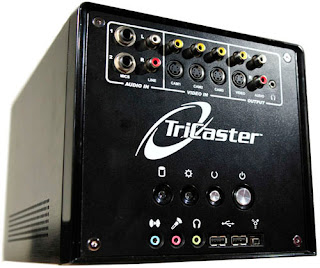Every now and then a product comes along that makes people in a certain industry sit up and pay attentions. Back in the 90's it was
NewTek with the
Video Toaster for the
Commodore Amiga Platform.
Back in the day, I was involved with using the Amiga in video production when it was given to the cable TV studio I worked for as a grant project. We received it along with a
genlock (used to sync the computer video to the same timing of an incoming video signal and overlay graphics on top of that video signal) and some basic titling software. One of the first titling products that we worked with was called
Scala, which is now one of the defacto digital signage products available. A local PBS station installed an Amiga in their studio and they were having issues integrating it. They received my name from Commodore and called me to come in and look at it. With my video editing and engineering background, I ended up staying and working with them editing show packages and eventually getting an FCC broadcast license and operate the transmitter.
This station then received an ALPHA unit of a new product called a Video Toaster. It was a hardware/software combination that gave you 3-4 video inputs and allowed you to do real-time video switching, with 3D effects and add titling. The cost of this total product was FAR below the cost of any comparable video switching unit at the time. Along with this product came an extra add-on of a 3D rendering program called
Lightwave 3D. I do believe I was the first person to use a Toaster in on-air broadcast use on the East Coast of the US.
NewTek produced the Toaster, as well as introducing a new product line called the Tricaster which was basically a video switcher, web streamer, graphics and video editor in a self contained small form factor (ala Shuttle PC) box, running Windows XP.

This box originally had 3 analog composite/S-Video inputs as well as audio line and Mic inputs as well as Composite/S-Video output with line level audio outputs. It allows you to mix 3 live video sources, pre-recorded video and graphics using 3D video effects as well as having a downstream keyer for lower thirds and other overlay graphics. The box also has the ability to use a network connected computer as a video source by running a special program on the client, which then shows up as a "VGA" source. Not only does it scale that VGA input for video, but you can then use the DVI output to display a clean unscaled version of the VGA input to a monitor or projector. This works great for still slides, but not good for anything with moving video.
The interface is controlled with standard keyboard and mouse, however, NewTek offers a a usb attached control surface with a standard "T" bar as well as input buttons ala a standard video switcher interface.
There have been new models of the TriCaster introduced over the years which included models with more inputs, Component inputs, SDI input and "Mini" model with HDMI or SDI. There have also been new technologies supported such as
NDI that is now used by many vendors as a way to shuttle HD video over a network.
The latest models also support a larger control surface, as well as an external DDR controller (controls the built in "VCR" features) as well as LiveType which is an external CG program to allow a second person to update and create title graphics on the fly.
One other neat feature of this box is that it supports the "Virtual Set" feature, which allows you to sit in front of a
green screen and look like you are sitting in the middle of professional studio, including shadows, reflections and multiple cam angles.
So all in all, this box is literally a TV studio in a box..with video editing features and streaming (h.264, Flash and Windows Media) this box is bang for the buck. Check out NewTek's latest offerings
here.



